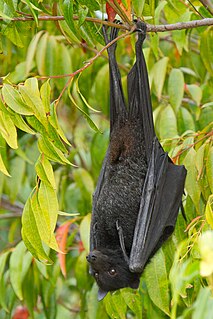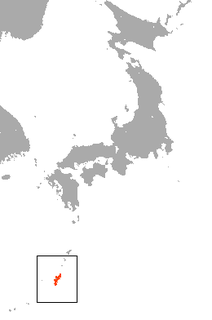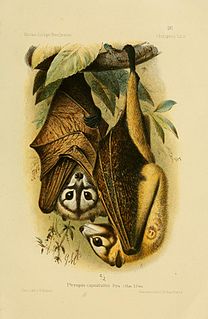The large Palau flying fox is an extinct species of medium-sized megabats from the Palau Islands in Micronesia. It had brownish fur with long, silvery hairs on its belly, and a wingspan of about 60 cm. It probably became extinct around 1874, possibly due to overhunting. It is known from two specimens, one of which is in the Natural History Museum, London.

The Guam flying fox, also known as the little Marianas fruit bat, was a tiny megabat from Guam in the Marianas Islands in Micronesia that was confirmed extinct due to hunting or habitat changes. It was first recorded in 1931 and was observed roosting with the larger and much more common Mariana fruit bat. The last specimen was a female found roosting at Tarague cliff in March 1967, but it escaped capture. An unconfirmed sighting took place sometime during the 1970s and no other individuals have been sighted since then.

Pteropus is a genus of megabats which are among the largest bats in the world. They are commonly known as fruit bats or flying foxes, among other colloquial names. They live in South Asia, Southeast Asia, Australia, East Africa, and some oceanic islands in the Indian and Pacific Oceans. There are at least 60 extant species in the genus.

The black flying fox or black fruit bat is a bat in the family Pteropodidae. It is among the largest bats in the world, but is considerably smaller than the largest species in its genus, Pteropus. The black flying fox is native to Australia, Papua New Guinea, and Indonesia. It is not a threatened species.

The Vanuatu flying fox or white flying fox is a species of flying fox in the family Pteropodidae. It is endemic to Vanuatu. It is most closely related to the Samoa flying fox.

The silvery flying fox, also known as Ambon flying fox, or silvery fruit bat, is a megabat in the genus Pteropus from eastern Indonesia. It is known from a single, damaged, and immature specimen that was thought to have been from Ambon, but may in fact have been collected on Gebe Island. Although often included in Pteropus chrysoproctus, it was reinstated as a separate species in 2008.
Pteropus brunneus is an extinct species of flying fox in the family Pteropodidae. It was said to be found at Percy Island, southeast of Mackay, Queensland, off the northeast coast of Australia.

The Banks flying fox is a species of megabat in the family Pteropodidae. It is endemic to Vanuatu. Its natural habitats are subtropical or tropical dry forests and subtropical or tropical swamps. These small fruit bats are about 15 cm. long with grey and brown on its head and back with a yellow-orange neck and yellow-gray bellies. Its diet consists of coconut flowers and Vaveli trees fruit since its home is tropical.

Gilliard's flying fox is a species of flying fox in the family Pteropodidae. In Spanish, the common name is zorro volador de Gilliard. It is endemic to Papua New Guinea. It is known from only three specimens.

The gray flying fox is a species of flying fox in the family Pteropodidae. It is not to be confused with the grey flying fox. It is found in Indonesia, but not in the Philippines, despite occasional reference to such. Very little is known about this species. The gray flying fox has small size and neutral coloration with a brownish head and an orange abdomen. It probably roosts individually or in small groups. It was listed on appendix II of CITES, and is classified as "Data Deficient" by the IUCN. This species has been decimated by hunting for bushmeat in Indonesia. The hunters use fishing hooks, ropes, and other supplies to hunt the bats. The ropes and hooks are placed along their flight paths, tearing and ensnaring the bats' wings when are flying. In the course of a hunting season, entire colonies can be killed.

The white-winged flying fox, also known as the mottle-winged flying fox is a species of bat in the family Pteropodidae. They are endemic to the Philippines. Their natural habitats are subtropical and tropical dry forests. In 2008, Giannini et al. revived the genus Desmalopex and placed D. leucopterus in it.

The Okinawa flying fox is a species of megabat in the genus Pteropus. It is endemic to possibly Japan. It was previously listed as extinct by the IUCN, but because the two known specimens are taxonomically uncertain and of unknown provenance, it was changed to 'Data Deficient'. Some place this animal into synonymy under Pteropus mariannus. Two specimens are in the British Natural History Museum, and the whereabouts of the third is unknown. Two of the specimens are believed to have come from Southeast Asia, so the true distribution of the Okinawa flying fox is unknown.

The great flying fox, also known as the greater flying fox or Bismarck flying fox, is a species of megabat in the genus Pteropus, found throughout lowland areas of New Guinea and in the Bismarck Archipelago. Conflicting evidence suggests that its closest relative is either the spectacled flying fox or, jointly, the Pelew and insular flying foxes. Two subspecies are recognized. At up to 1.6 kg (3.5 lb) in weight, it is among the heaviest bats in the world and the largest bat in Melanesia. It is a gregarious animal which roosts with hundreds or thousands of individuals. In part due to its wide variation in color, it has many taxonomic synonyms, including Pteropus degener, Pteropus papuanus, and Pteropus sepikensis. It may forage during the day or night in search of fruit, including figs or fruits from the family Sapotaceae. It is considered a least-concern species by the IUCN, though its numbers have been negatively impacted by what appeared to be a disease, as well as by hunting for bushmeat that occurs across its range.

The Ceram fruit bat or Seram flying fox is a species of megabat in the family Pteropodidae. It is endemic to the mountainous forests of two Maluku islands, Buru and Seram, including the Manusela National Park on Seram. They were once present on the nearby Ambon Island, but probably not anymore. The habitat has an area of less than 20,000 km2, and is decreasing due to logging. For this reason, and because of hunting by the local population, these species are listed as vulnerable by the IUCN since 1996.

Pteropus pelagicus is a species of fruit bat in the family Pteropodidae. It includes two subspecies that were formerly recognized as full species— Pteropus insularis and Pteropus phaeocephalus. It is endemic to Micronesia. It is threatened by habitat loss.

The insular flying fox or Pacific flying fox is a species of flying fox in the family Pteropodidae. It is geographically widespread, the most widespread flying fox in the Pacific: it is found in American Samoa, the Cook Islands, Fiji, New Caledonia, Niue, Papua New Guinea, Samoa, the Solomon Islands, Tonga, and Vanuatu.

The Bismarck masked flying fox is a species of flying fox in the family Pteropodidae found in Papua New Guinea and named after the Bismarck Archipelago. It was once considered a subspecies of Pteropus temminckii before being reassessed in 2001. This species has two subspecies, P. c. capistratus and P. c. ennisae. The IUCN classified it as Near Threatened in 2009, noting that the rate of decline is almost high enough to reclassify the species as Vulnerable.

The Rennell flying fox is a species of flying fox found in the Solomon Islands. It is an endangered species risking extinction.

The big-eared flying fox is a species of bat in the family Pteropodidae, larger bats who subsist largely on fruits. The species is distributed across a range in Indonesia, Papua New Guinea and islands nearing the Cape York peninsula at the northeast of Australia, at elevations less than 500 metres and often in coastal mangroves.
The large Samoan flying fox is a species of fruit-eating megabat whose type specimen was originally collected in Samoa in 1856, but was not identified as a new species until 2009. The only known specimen was collected by an American expedition to Samoa in 1838–1842. It was rediscovered by Smithsonian mammalogist Kristofer Helgen preserved in alcohol. It was the largest known bat from Polynesia. As the type specimen is dead, and no other examples of the species are known, it is believed to be extinct.

















